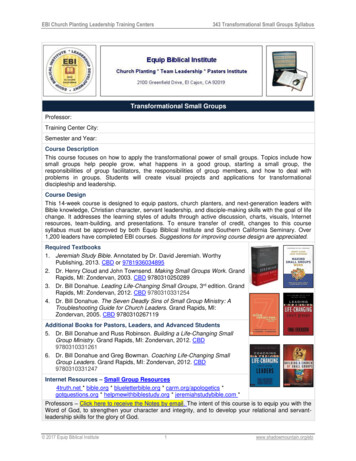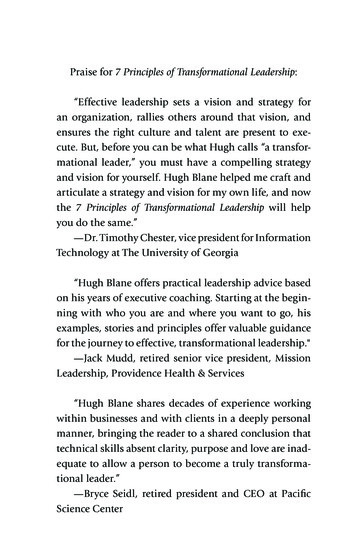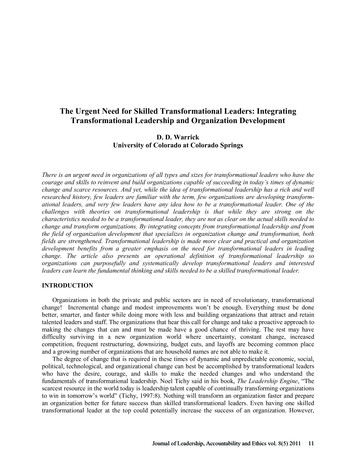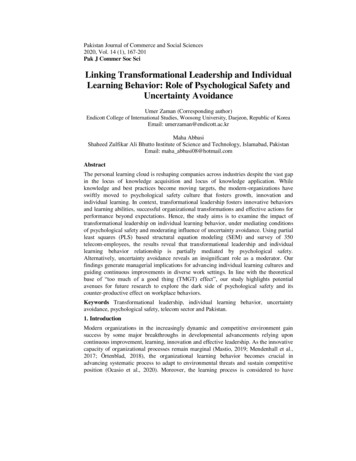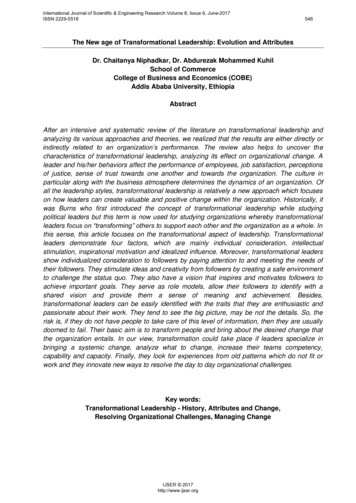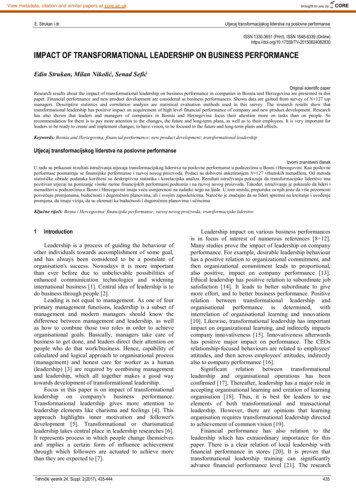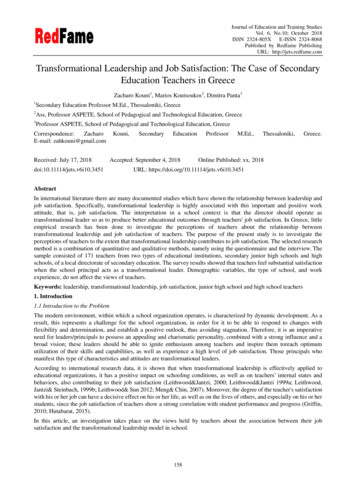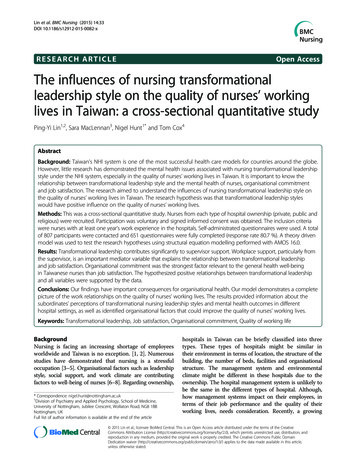
Transcription
Lin et al. BMC Nursing (2015) 14:33DOI 10.1186/s12912-015-0082-xRESEARCH ARTICLEOpen AccessThe influences of nursing transformationalleadership style on the quality of nurses’ workinglives in Taiwan: a cross-sectional quantitative studyPing-Yi Lin1,2, Sara MacLennan3, Nigel Hunt1* and Tom Cox4AbstractBackground: Taiwan’s NHI system is one of the most successful health care models for countries around the globe.However, little research has demonstrated the mental health issues associated with nursing transformational leadershipstyle under the NHI system, especially in the quality of nurses’ working lives in Taiwan. It is important to know therelationship between transformational leadership style and the mental health of nurses, organisational commitmentand job satisfaction. The research aimed to understand the influences of nursing transformational leadership style onthe quality of nurses’ working lives in Taiwan. The research hypothesis was that transformational leadership styleswould have positive influence on the quality of nurses’ working lives.Methods: This was a cross-sectional quantitative study. Nurses from each type of hospital ownership (private, public andreligious) were recruited. Participation was voluntary and signed informed consent was obtained. The inclusion criteriawere nurses with at least one year’s work experience in the hospitals. Self-administrated questionnaires were used. A totalof 807 participants were contacted and 651 questionnaires were fully completed (response rate 80.7 %). A theory drivenmodel was used to test the research hypotheses using structural equation modelling performed with AMOS 16.0.Results: Transformational leadership contributes significantly to supervisor support. Workplace support, particularly fromthe supervisor, is an important mediator variable that explains the relationship between transformational leadershipand job satisfaction. Organisational commitment was the strongest factor relevant to the general health well-beingin Taiwanese nurses than job satisfaction. The hypothesized positive relationships between transformational leadershipand all variables were supported by the data.Conclusions: Our findings have important consequences for organisational health. Our model demonstrates a completepicture of the work relationships on the quality of nurses’ working lives. The results provided information about thesubordinates’ perceptions of transformational nursing leadership styles and mental health outcomes in differenthospital settings, as well as identified organisational factors that could improve the quality of nurses’ working lives.Keywords: Transformational leadership, Job satisfaction, Organisational commitment, Quality of working lifeBackgroundNursing is facing an increasing shortage of employeesworldwide and Taiwan is no exception. [1, 2]. Numerousstudies have demonstrated that nursing is a stressfuloccupation [3–5]. Organisational factors such as leadershipstyle, social support, and work climate are contributingfactors to well-being of nurses [6–8]. Regarding ownership,* Correspondence: nigel.hunt@nottingham.ac.uk1Division of Psychiatry and Applied Psychology, School of Medicine,University of Nottingham, Jubilee Crescent, Wollaton Road, NG8 1BBNottingham, UKFull list of author information is available at the end of the articlehospitals in Taiwan can be briefly classified into threetypes. These types of hospitals might be similar intheir environment in terms of location, the structure of thebuilding, the number of beds, facilities and organisationalstructure. The management system and environmentalclimate might be different in these hospitals due to theownership. The hospital management system is unlikely tobe the same in the different types of hospital. Although,how management systems impact on their employees, interms of their job performance and the quality of theirworking lives, needs consideration. Recently, a growing 2015 Lin et al.; licensee BioMed Central. This is an Open Access article distributed under the terms of the CreativeCommons Attribution License (http://creativecommons.org/licenses/by/2.0), which permits unrestricted use, distribution, andreproduction in any medium, provided the original work is properly credited. The Creative Commons Public DomainDedication waiver ) applies to the data made available in this article,unless otherwise stated.
Lin et al. BMC Nursing (2015) 14:33body of research which demonstrates that subordinates’perceptions of their working conditions are related toleadership behaviour [9].Nursing is often defined as the kind of job with longworking hours and high job stress [10]. Such factors aslow job control, high job demands and low supportivework relationships are correlated with stress in nurses[11] and high rate of staff turnover [12]. Research hasshowed that nursing transformational leadership style isassociated with employees’ job satisfaction [13] andgeneral health well-being [14], though the mechanismbetween nursing transformational leadership style andthe quality of nurses’ working lives is not clear. Thereis a need to understand the mechanism betweentransformational leadership style and quality of workinglife in health care professions. Therefore, we propose atheory-driven model to examine this mechanism by usingstructural equation modelling.Transformational leadership style and supervisor supportTransformational leaders stimulate their subordinates toshare a vision and use goals as inspirational motivation.Subordinates are encouraged to think of old problems innew ways and are seen individually. Additionally, followersare influenced by a transformational leader who istrustworthy, respectable and dedicated. By applyingtransformational leadership, leaders can confidently dealwith a complex and rapidly changing working environment. The effectiveness of transformational leadership isevident.Supervisor support may be one of the significantfactors in keeping nurses satisfied in their work [15].Nursing supervision has a positive influence onnurses’ well-being and their ability to cope with theirstressful work situations [16]. We build on previous research by examining whether the relationship betweentransformational leadership and the quality of nurses’working lives was mediated by subordinates’ perceivedsupport from their supervisors. We proposed a conceptualmodel which is comprised of five key variables. The modelis presented in Fig. 1. We assumed that transformationalleadership style will have either a negative/positiveinfluence on the general health well-being of nursesand that the relationship will be mediated by supportwithin the organisational system. In addition, the effects oftransformational leadership style on the general healthwell-being of nurses will be buffered by job satisfactionand organisational commitment.The role of leadership in supportLeaders should be able to influence and inspire others,develop strategies, organise resources and empowerpeople [17]. The leader is in a position with multipledimensions, such as being a clinical expert in their fieldPage 2 of 9as well as being a manager in a hospital. In the nursingsetting, change management, negotiating ability andconflict management are essential skills that nursesshould develop to become effective leaders [18]. There isno optimal leadership style, as the personality of theleader, subordinates, and the situation can all influenceleadership effectiveness [19]. The perceptions of leadersand subordinates are also inconsistent, with subordinatesoften preferring leaders with more clearly expressedleadership behaviour than leaders themselves prefer todemonstrate [20]. Leadership style may affect theperformance of nurses directly and may have positiveor negative effects. It is also associated with staffturnover [21, 22]. Leadership/management style is one ofthe main sources of distress for nurses [23]. It is alsosuggested that occupational stress has an adverse influenceon the quality of working life for nurses [24].Taken together, leadership may affect both nurses’work performance and their quality of the working life.Developing a transformational nursing leadership style isan alternative organisational strategy to improve nurseperformance and promote better patient care outcomes[25]. It may further enhance the quality of the workinglife of nurses.The following hypotheses examined the main effectsof transformational leadership styles on nursing mentalhealth outcomes:Hypothesis 1: Transformational leadership styles arerelated to nursing mental health outcomes.Transformational leadership style is associated withsubordinates’ working conditions [26]. Training managersin transformational leadership style may have a positiveinfluence on health care workers’ mental health over time[27], although it may present an incomplete picture of theimpact of work and the relationship on well-being withoutconsidering working conditions [28]. Job content is alsoincluded as one of the variables in the proposed model.Hypothesis 2: The higher the level of transformationalleadership the higher the level of perceived supervisorsupport.Follower work attitudesWork attitudes have a strong influence on the quality ofnurses’ working lives. Job satisfaction and organisationalcommitment are outcome variables of nurses’ workattitudes. Job satisfaction concerns how an employeefeels about his or her job and is related to organisationalcommitment. These are important to the quality of anemployee’s working life. Factors such as job content, jobsatisfaction and organisational commitment are presentedin the proposed model. Job satisfaction is a predictorof the quality of nursing working life. In contrast, jobdissatisfaction can be the main predictor of intentionto leave nursing [29].
Lin et al. BMC Nursing (2015) 14:33Page 3 of 9Fig. 1 The proprosed path model of relationships. Notes: TL Transformational Leadership Style; JC Job Content; JS Job Satisfaction;OC Organisational Commitment; GH General Health Well-beingLeadership, particularly the transformational leadershipstyle, is associated with higher levels of job satisfaction[30]. Transformational leaders may help ensure employees’job satisfaction and psychological well-being [31, 32].In Taiwan, nursing directors display transformationalleadership more frequently in their workplaces andnursing faculty staff exposed to this leadership styleare moderately satisfied in their jobs [33]. Nurses withsupervisors employing a transformational leadership stylewere less likely to experience decreased job satisfactionthan nurses with supervisors employing other styles [34].Therefore, supervisors presenting a transformationalleadership style can be perceived as providing supervisorsupport in the organisation. Job satisfaction and organisational commitment are two factors which moderate theeffects of general health well-being and transformationalleadership style. We aimed to test the relationship amongsupervisor support, job satisfaction, and organisationalcommitment.Hypothesis 3: The higher the level of supervisor supportwill indicate a higher level of job satisfaction.Hypothesis 4: There will be a positive correlation betweensupervisor support and organisational commitment.Organisational commitment is highly associated with thequality of nurses’ working lives. One of the most importantperspectives is to define a proper methodology for anoverall assessment of the quality of the working life ofnurses. The aim of the present study was to explore nursingleadership style and its relationship between mental healthoutcomes of nurses.Hypothesis 5a: The higher the level of job satisfaction,the higher the level of organisational commitment.Hypothesis 5b: The higher the level of job satisfaction,the lower the level of poor general health well-being.Hypothesis 5c: The higher the level of organisationalcommitment, the lower the level of poor general healthwell-being.According to Karasek’s theoretical model [35], jobdemands and work control are two important workenvironment elements. In this approach, high job strain isviewed as the consequence of an individual’s ability tocope with high job demands under conditions of lowcontrol. Payne and Fletcher [36] stated that less effort isneeded to cope with high job strain if support is availablein the organisational system. Karasek’s model wasreconceptualized to include social support and wasused widely to measure work characteristics and jobstrain. High levels of support from supervisors andco-workers play a moderating role against the negativeeffects of high strain jobs on levels of work performance[37], so supervisors will have a major influence onemployees’ mental health. In addition, supervisor supportmight play a mediator role in raising the positive effects ofthe quality of the working life of nurses. Thus, it might bepossible to improve organisational health by enhancingthe leadership styles of supervisors.As stated before, the general aim of the present studywas to explore nursing leadership style and its relationshipbetween the mental health outcomes of nurses. The resultsare presented in two parts: data analysis and modeldevelopment. In the first part, a basic background ofthe quantitative phase of the study is described. Thesecond part of the study describes the utility of structureequation modelling (SEM).MethodResearch designThis was a cross-sectional quantitative study. The datawere collected using a self-report questionnaire that consisted of six sections: demographic information, leadershipstyle, job content, general health well-being, organisationcommitment and job satisfaction. Demographic data wereobtained, which included age, gender, marital status, gradeof nursing practice, educational level, working experienceand work tenure.Sampling StrategyThe surveys were conducted in Chinese and all scaleswere pilot tested. The participants were selected from 12hospitals in Taiwan, 4 hospitals in each type of ownership.Participation was voluntary and signed informed consentwas obtained. The nurses’ eligibility to participate in thisstudy were those graded from N1 (basic training) to N4(specialized training and research) and those with atleast one year’s work experience in their current hospital.The overall response rate was 80.7 %. A total of 651 valid
Lin et al. BMC Nursing (2015) 14:33Page 4 of 9questionnaires were completed and returned. Participantdemographic characteristics are presented in Table 1. Atotal of 41.5 % respondents worked in private hospitals,34.4 % worked in public hospitals and the remaining24.1 % worked in hospitals run by religious organisations.The mean age of the participants were 30.5 (SD 6.2)years. The average work tenure was 4.5 (SD 4.5) years.The majority of respondents were female and more thanhalf of them were single. In terms of grade of nursingpractice and educational level, there was a statisticallysignificant correlation among the three types of hospital.MeasuresNursing leadership styleParticipants completed the Multifactor LeadershipQuestionnaire [38], which measures the following dimensions of transformational leadership: idealized influence,inspiration motivation, intellectual stimulation, and individualized consideration. Participants were asked to indicatetheir degree of perception about transformational leadership style regarding their leader (one level above) by using afour-point Likert scale ranging from ‘not at all (0)’ to‘frequently, if not always (3)’. Cronbach’s alpha (α) fortransformational leadership was .975 which demonstratesvery good reliability (an alpha of greater than .70). In thepresent study, both composite reliability and the value ofthe average variance extracted (AVE) are employed toassess convergent validity. Adequate convergent validity isassessed with reliabilities above .80 and the value of AVEabove .50 [39]. The value of the composite reliability inthe transformational leadership scale is .98 (exceeding .80)and the value of AVE is .70 which can be seen as goodconvergent validity.Job contentJob content was measured using Karasek’s Job ContentQuestionnaire (JCQ) [40]. This instrument comprised of22 items and three dimensions: job control, personaldemands, and workplace support. The job control scale isthe sum of the two subscales, skill discretion and decisionauthority. The workplace support scale is the sum of thetwo subscales, supervisor support and co-worker support.Participants were asked to indicate social and psychologicalcharacteristics of their jobs using a four-point Likert scaleranging from strongly disagree (0) to strongly agree(3). Cronbach’s alpha was .721 for the Job ContentQuestionnaire. In the job content scale, the value ofthe composite reliability was .89 in the supervisorsupport scale and the value of AVE is .68 which is anacceptable level of convergent validity.Job satisfactionIn the present study, the job satisfaction scale of theOccupational Stress Indicator (OSI; [41] was employed. Itincluded 22 items in its original form. As it was conductedwith nurses who only read and spoke Mandarin, theChinese version of the job satisfaction scale whichcomprised 12 items from the OSI, was used. TheChinese version of job satisfaction has been tested andvalidated in a Taiwanese population [42]. Participants wereasked to rate their degree of satisfaction about their jobsusing a six-point Likert scale ranging from very unsatisfied(1) to very satisfied (6). Cronbach’s alpha was .939, thevalue of the composite reliability was .94 and the value ofAVE was .57 which is an acceptable level of convergentvalidity.Organisational commitmentOrganisational commitment is the level of psychologicaland social attachment an individual has to an organisation.Organisational characteristics are key factors in nurseattraction and retention. One of the main approaches tomeasuring organisational commitment in health care professionals is the Organisational Commitment QuestionnaireTable 1 The mean scores of variables among three types of hospital ownershipTransformational LeadershipSupervisor SupportJob SatisfactionOrganisational CommitmentGeneral Health Well-beingPrivate hospitalPublic hospitalReligious hospitalM, SDM, SDM, SD(Range)(Range)(Range)32.50, 10.7632.98, 12.1231.24, 11.43(0–52)(0–52)(0–52)7.22, 2.187.27, 2.357.06, 2.31(0–12)(0–12)(0–12)45.38, 7.2146.49, 7.5446.12, 7.18(17–70)(12–72)(25–71)49.57, 11.9354.33, 11.4955.50, 11.77(8–76)(14–83)(21–84)15.07, 5.0014.52, 5.1513.20, 5.09(1–32)(0–31)(2–26)POverallM, SD(Range)NS32.36, 11.41(0–52)NS7.20, 2.27(0–12)NS45.94, 7.33(12–72) 0.00152.64, 12.01(8–84)0.00114.43, 5.12(0–32)
Lin et al. BMC Nursing (2015) 14:33(OCQ), which is a 15 item questionnaire designed todescribe global organisational commitment as a totalcommitment scale [43]. A seven point Likert scaleranging from strongly disagree (0) to strongly agree(6) was used to indicate degree of organisational commitment. Cronbach’s alpha was .878. A total scoringmethod was performed in this scale.General health well-beingThe 12-item General Health Questionnaire [44] wasdeveloped to measure non-specific psychiatric disorders.The GHQ-12 (Chinese version) has been tested andvalidated in Chinese societies [45]. In the present study, theGHQ-12 was applied to measure the perceptions of theparticipants regarding their health status. Responses werecoded by using an un-weighted four-point Likert method(0-1-2-3). Cronbach’s alpha was .815 for the GHQ.Ethical considerationsEthics approval was granted from the Institute of Work,Health and Organisations at the University of Nottinghamand from the Institutional Review Board at ChanghuaChristian Hospital (IRB, Taiwan).Statistical analysisPearson correlations were used to detect the correlationsof all the variables in the model. Analysis of variance(ANOVA) was used for continuous parametric data todetect the differences among the three types of hospital.Scheffe’s post hoc tests were applied for comparisons ofmeans which involve more than two means at a time.SEM as used to examine the pattern of the relationshipsamong all variables. Goodness-of-fit is evaluated byusing those fit indicators as well as the comparative fitindex (CFI), nonnormed fit index (NNFI/TLI), and theroot mean square error of approximation (RMSEA) [46,47]. To assess model fit, the applied fit indices are thevalues of chi-square where .05 indicates a good fit [48].Values of below .08 for RMSEA indicate acceptable fit[49]. In addition, values of CFI and NFI .90 indicates agood fit [50]. SEM was applied in the assessment ofeach construct and respective items which includedthe measurement model. In the assessment of themeasurement model, SEM has been proven to have moreadvantages than multiple regressions in evaluation themodel fitting. SPSS version 16.0 was used to performexploratory factor analysis (EFA) and AMOS (Analysis ofMoment Structure) version 16.0 [51] was used to performconfirmatory factor analysis (CFA). EFA was used formodel development and CFA was used for model testing.Hypothesis testing involved that conducting an evaluationof whether a SEM was consistent with the data or not. Tofollowing fit indices were used in this study such asChi-square (χ2), RMSEA, CFI, TLI and NFI.Page 5 of 9ResultsRegarding the internal reliability of the five subscales,Cronbach’s alpha (α) scores for each subscale exceededthe level of .70. In order to test Hypotheses 1 and 2,correlation analyses were conducted. The bivariatecorrelations are displayed in Table 2, which shows means,standard deviations, and the correlations of all thevariables in the model. All correlations of the variablesare statistically significant The strongest correlationwas between supervisor support and transformationalleadership style (r .735). Thus, hypotheses 1 and 2are supported.Work attitude variables, job satisfaction and organisational commitment were significantly correlated withgeneral health status. High scores of job satisfaction ororganisational commitment are associated with betterhealth status.There was a statistically significant difference inboth organisational commitment level and generalhealth well-being between the three types of hospitals(see Table 1). An analysis of variance (ANOVA) showedthat the scores of organisational commitment was significant, F (2,648) 16.254, p .001. Post hoc analyses usingthe Scheffé post hoc criterion for significance indicatedthat the average number of errors was significantly lowerin the private hospitals (M 49.57, SD 11.93) than in theother two ownership hospitals (public and religious).Regarding the scores of general health status, it wassignificant statistically in three ownership hospitals,F (2,648) 6.798, p .001. The scores were significantlyhigher in private hospitals (M 15.07, SD 5.00) whichrevealed the worse health status. However, there was nostatistically significant difference in job satisfaction amongthe three hospitals. These results represented the degreeof organisational commitment with the highest scoresfound in the religious hospitals when compared with theother hospitals.Model developmentProposed modelSEM was used to test the proposed model fit among allthe variables. Figure 1 presents the initial model of theTable 2 Correlations for all the variables in the proposed modelVariablesCorrelations11. Transformational leadership22. Supervisor support.735**3. Job satisfaction.475**.518**.321**.359**4. Organisational commitment5. General health well-being345111.552**1 .151** .169** .289** .389** 1** Correlation is significant at the 0.01 level
Lin et al. BMC Nursing (2015) 14:33present study. This model was used to test the relationship between transformational leadership styles of nursingand nursing health outcomes. This model consists ofstructural parameters for the following: 1) direct pathbetween transformational leadership and supervisor support; 2) direct path between transformational leadershipand job satisfaction; 3) indirect path between supervisorsupport, job satisfaction, and general health well-being; 4)indirect path between transformational leadership styleand all variables. Fit of the overall model was assessed(Chi square 0.241; df 3; p .971) and the fit indices(CFI 1; TLI 1.009; NFI 1.000) have a value greaterthan 0.9 which indicates good model fit. In addition, thevalue for RMSEA is less than .05 (RMSEA .000). Thisimplies a good model fit. The model was tested byestimating all the hypothesised paths. Non-significantpaths were dropped in a stepwise fashion so that onlysignificant paths were presented. Although, these resultsshowed a near-perfect model fit. According to the smalldegrees of freedom (df 3), it might caused by all thevariables are identified. However, from the results ofa good model fit with large sample size, it strengthensthe hypotheses of the conceptual model.The results presented in Fig. 2 show that transformational leadership had direct influence on supervisorsupport (β .74).More transformational leadership behaviours are relatedto greater supervisor support. Greater supervisor supportis related to greater job satisfaction (β .37), which in turnis positively related to greater organisational commitment(β .50). Thus, hypotheses 3-5a are supported. Accordingto these results, supervisor support has a mediation effecton the relationship between transformational leadershipbehaviours and job satisfaction. In addition, the effectof supervisor support on the level of organisationalcommitment was buffered by job satisfaction. Similarly,the results shown in Fig. 2 indicate that a higher level ofjob satisfaction was related to better general healthwell-being (β .11). Thus, Hypothesis 5b was supported. More commitment to the organisation had betterPage 6 of 9general health well-being (β .33). Thus, hypothesis 5cwas supported.DiscussionTransformational leadership continues to predominatein health care studies [52–54]. Nevertheless, a growingbody of nursing research has addressed the significanceof the relationship between transformational leadershipand job satisfaction of nurses. Ideally, transformationalleadership will create a motivating vision and enhancejob performance. However, the relationship betweentransformational leadership and work related mentalhealth variables are not clearly understood. In this study,we expected the transformational leadership styles ofnursing to influence nursing mental health outcomes.Based on the main hypotheses of the research, theresults were presented in the final model which revealedthe positive relationship between nursing transformationalleadership and general health status. The results alsoshowed that supervisor support plays a mediating rolebetween transformational leadership styles and jobsatisfaction. Supervisor support has a dramatic influenceon employees’ job satisfaction compared with otherfactors. In comparison to work demands, supervisorsupport plays an important role; in that it is morelikely to influence health outcomes of nurses in termsof job characteristics. Supervisor support was one of thejob characteristics highly associated with transformationalbehaviour. Supervisor support is a core transformationalbehaviour and it increases job satisfaction of nurses. Thisresult is concordant with previous studies [55]. The subordinates tend to have a higher level of job satisfaction whenthey perceive supervisor support as a specific behaviour oftransformational leadership styles. This provides avaluable contribution to the subordinates’ perceptionsof transformational leadership styles in terms of job satisfaction. Furthermore, leadership is an interactive processbetween the leader and the subordinate. Subordinates’perceptions of a leader are important as they reveal information about how subordinates perceive the behaviours ofFig. 2 The final model of the study. Notes: TL Transformational Leadership Style; SS Supervisor Support; JS Job Satisfaction;OC Organisational Commitment; GH General Health Well-being
Lin et al. BMC Nursing (2015) 14:33the leader and the causal relations by which these perceptions translate into the mental health outcomes of thesubordinate. In our study, transformational leadershipstyle also plays an important role in both job satisfactionand organisational commitment of nurses. Regardingthe quality of nursing working life, job satisfaction andorganisational commitment are particularly influential.Regarding demographic background, the age of theTaiwanese nursing workforce tended to be youngercompared to those in Western countries [56]. Theaverage age of employed nurses was 30.5 (SD 6.2)years. However, in western developed countries, theaverage age of employed nurses was more than40 years [57]. This reveals that the nursing professionis more likely to face difficulty with retaining itsworkforce in Taiwan. Hu et al.[58] reported that overtimeis one of the predominant outcomes related to the nursingworkforce. In addition, excessive workload has beenreported by 44.8 % of Taiwanese nurses as one of the mainreasons for quitting their jobs [59]. This may explainunfavourable working nature for retaining nurses.Regarding the ownership of the hospital, it is morelikely that ownership had less influence on job satisfaction of nurses. Job satisfaction scores reported bythe nurses were lower than other professions in Taiwan[60]. Regarding organisational commitment, the lowestscores on organisational commitment between the threetypes of hospital were found in private hospitals. Similarly,hospital ownership was associated with organisationalcommitment [61]. This implies that organisationalculture/climate could be a potential factor influencingorganisational commitment. There was a positive correlation between job satisfaction and organisationalcommitment, a similar result reported by Blegen [62].Organisational commitme
between nursing transformational leadership style and the quality of nurses' working lives is not clear. There is a need to understand the mechanism between transformational leadership style and quality of working life in health care professions. Therefore, we propose a theory-driven model to examine this mechanism by using structural .


